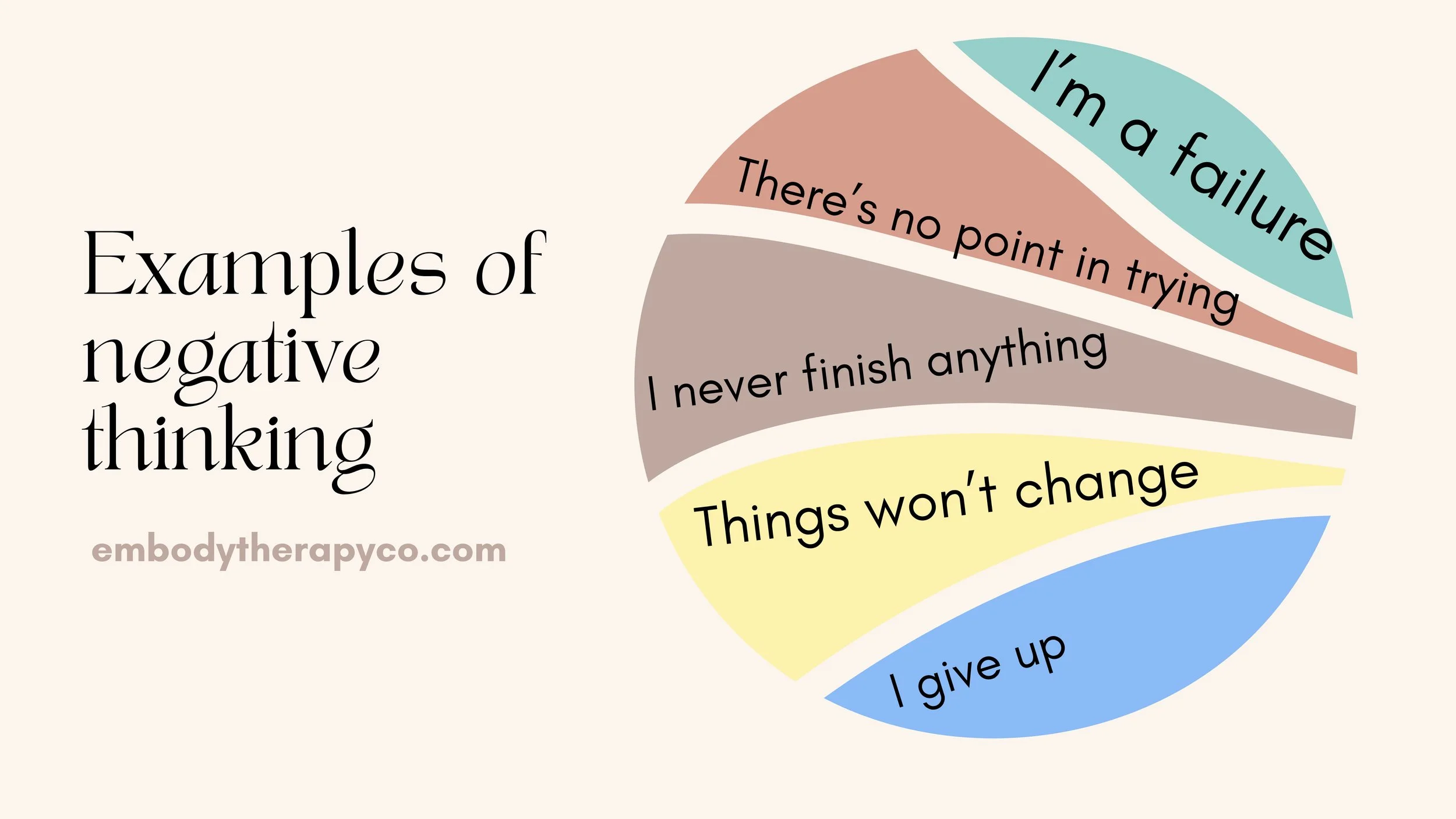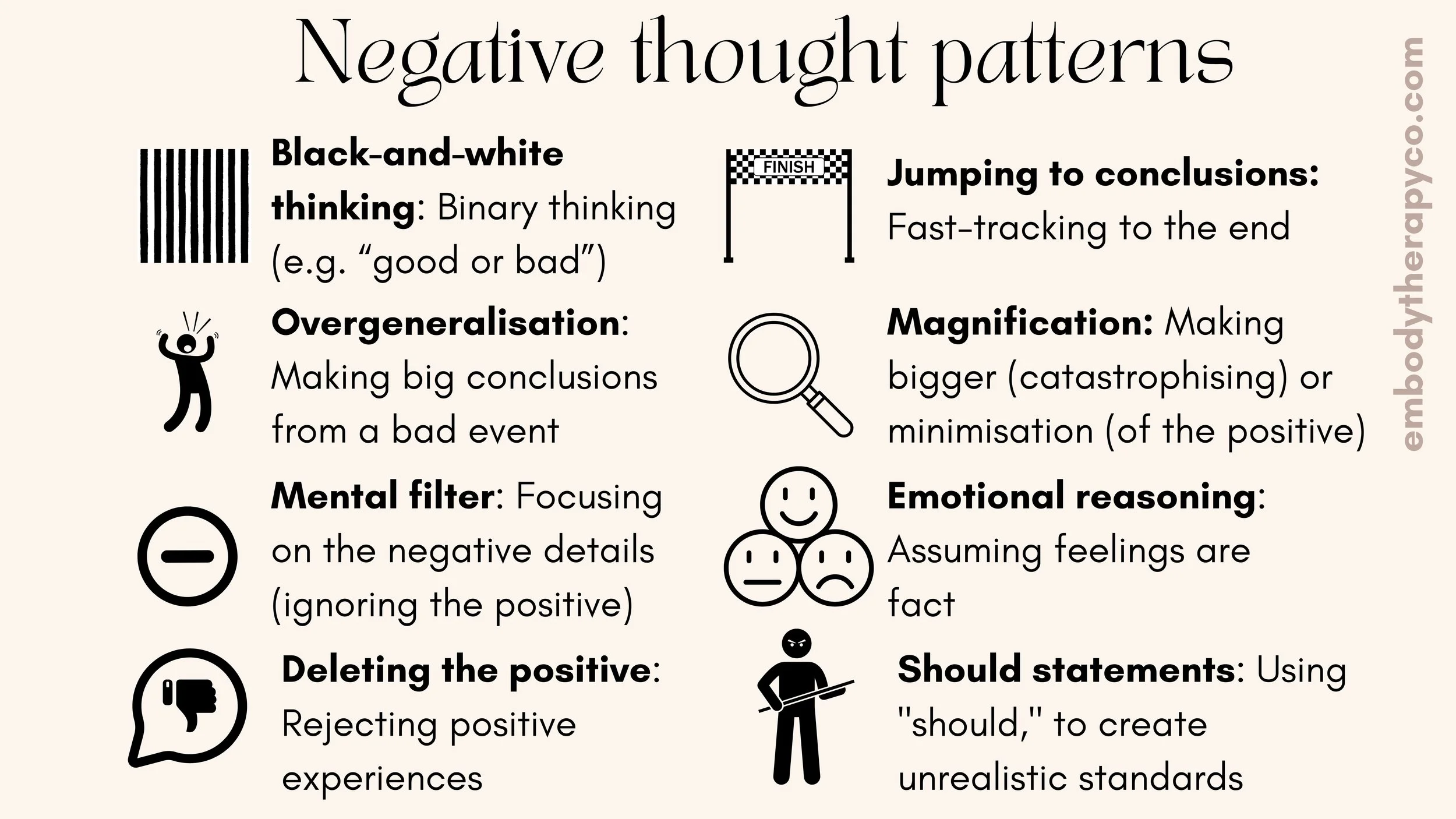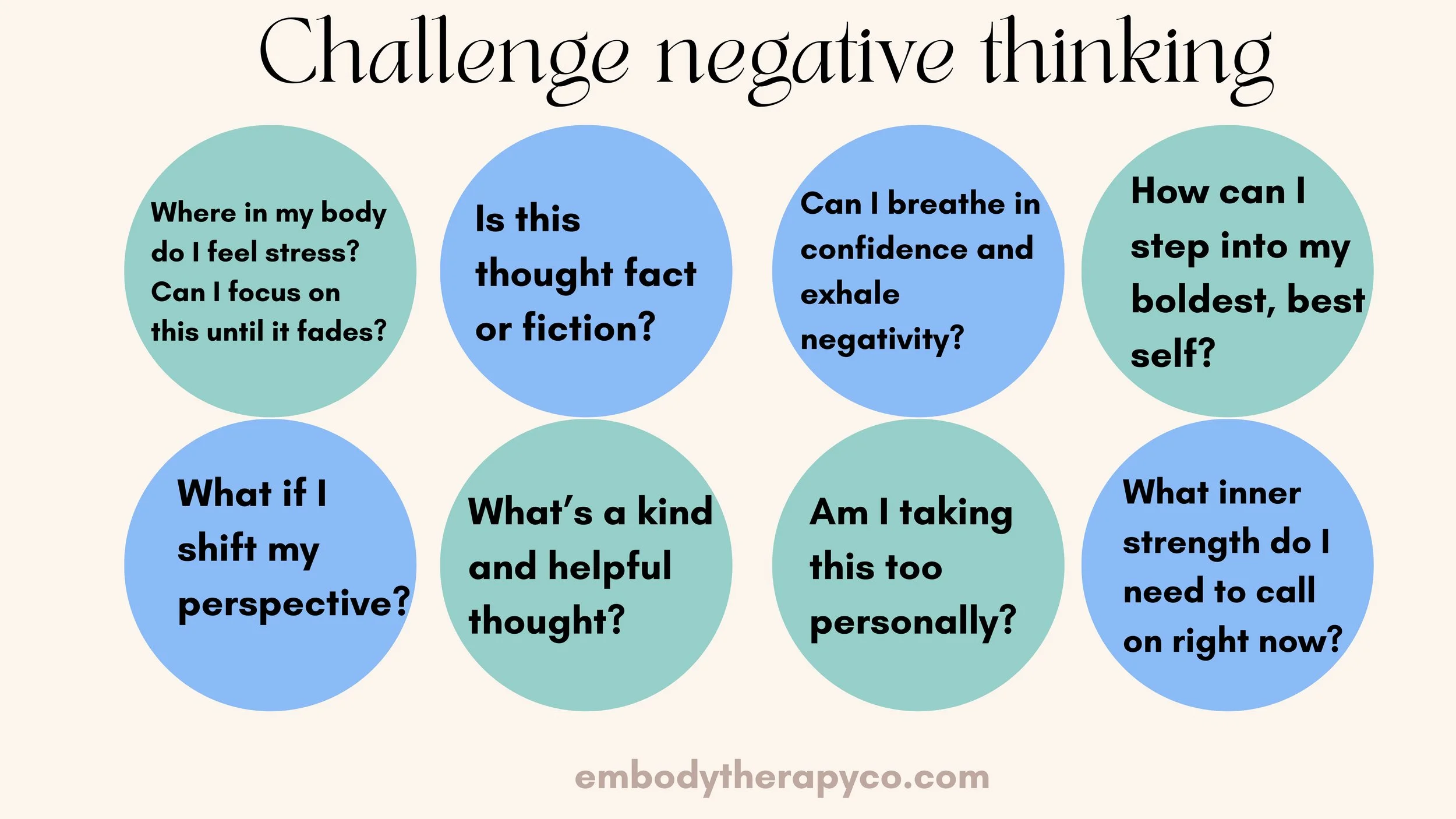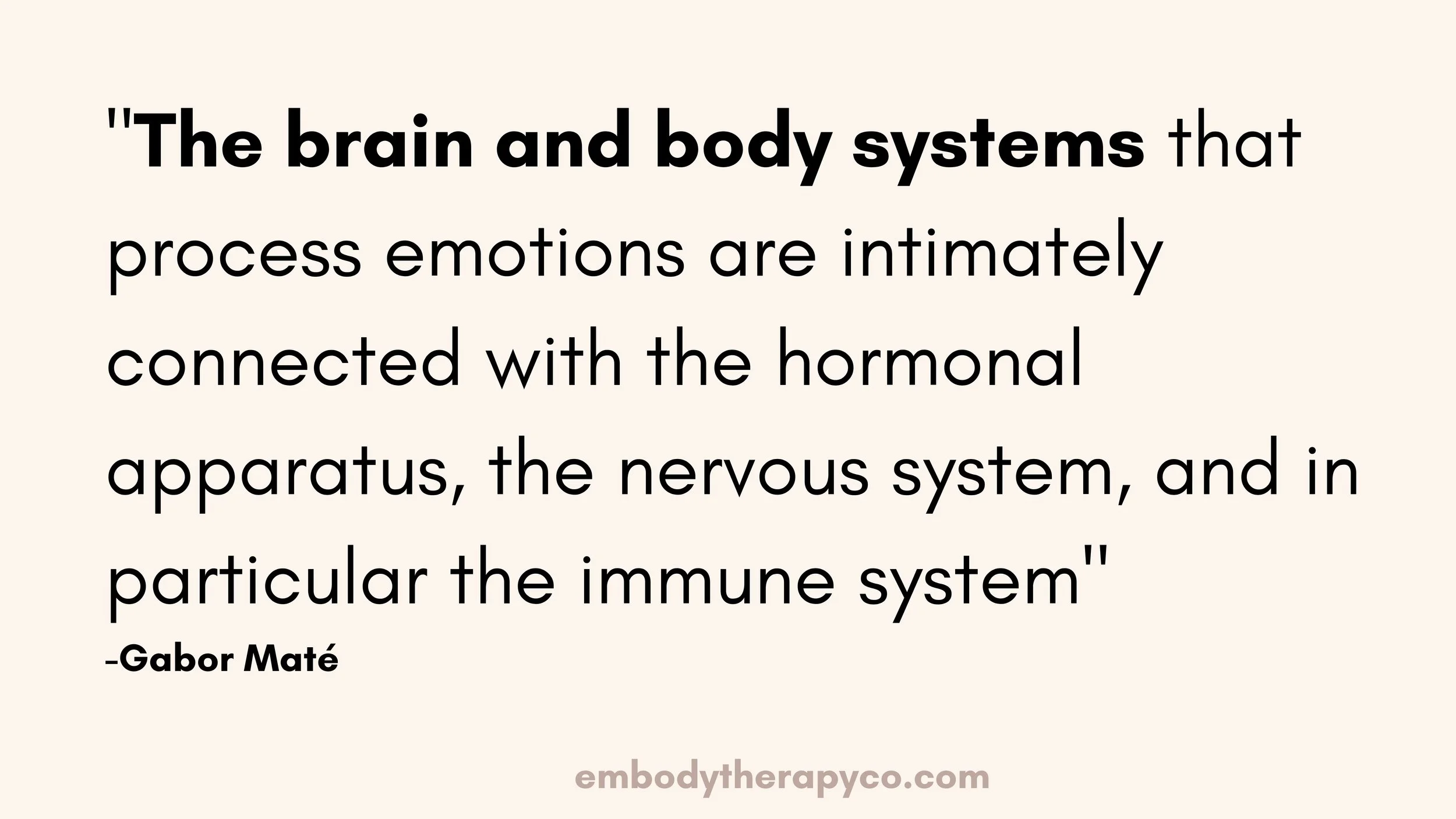Anxiety: Can I change automatic negative thoughts (ANTs)?
Automatic Negative Thoughts (ANTs) are thoughts that pop into your mind automatically, without you trying. They are usually negative, not always true, and can make you feel anxious or depressed. ANTs often show up quickly when something triggers them, and they usually involve bad thoughts about yourself, other people, or the future. Can we change negative thoughts? Yes, here’s how. (8.4.25.)
What are automatic negative thoughts (ANTs)?
You know how you can be really mean to yourself? Those are called Automatic Negative Thoughts, or ANTs. They usually get triggered when something tough happens, and they’re illogical. They often increase anxiety and stress. Negative thinking comprises of pessimistic black-and-white thoughts. The umbrella mentality is “everything is bad.”
Examples of negative thinking
We tend to think negatively as a form of survival, a built-in response known as negative bias. Our brains are wired to focus on threats and potential dangers, which helped our ancestors stay safe.
This instinct can lead us to overemphasise worries, doubts, and fears that don’t necessarily serve us. Negative thoughts often feel like truths, but they’re just habits formed over time.
Embodied practices can help us gently notice when we're slipping into this pattern. By tuning into the sensations in our body—whether it’s shallow breathing or tense shoulders—we can catch ourselves before the negative thoughts take over.
Checking in with ourselves and taking short breaks to pause, lets us see these thoughts for what they are without believing in them. Bringing in space to step away from stress also helps to come back with a fresh perspective.
Where do negative thoughts come from?
Negative thoughts are often rooted in our core beliefs about ourselves, which are formed in childhood. Our adult experiences, relationships, and interactions can also influence and shape our worldview.
Painful, confusing or traumatic experiences can also lead to one feeling unsafe and not good enough. Over time, the brain tries to make sense of these difficult experiences by forming limiting beliefs like “The world isn’t safe,” even if this is not true.
There are many ways we can react to difficult and traumatic experiences. Our mind and body naturally tries to protect us but sometimes the way we cope can lead to negative thinking. When stress happens, we typically go into the fight-flight-freeze-fawn stress response.
The stress response:
Fight — We become overly critical or angry, we often go on “fight” mode, trying to resolve the conflict through action, or we may turn inwards with self-blame
Flight — We try to escape uncomfortable feelings, leading to anxiety and racing negative thoughts about what could go wrong
Freeze — We shut down emotionally, feeling stuck or hopeless, with thoughts like "Nothing will ever get better.”
Fawn — We people-please to stay safe, constantly worrying about others' opinions and thinking "I'm only valuable if others approve of me."
Each of these reactions can plant seeds of negativity because they are rooted in fear and self-protection. Through simple embodied practices — like grounding, mindful breathing, or simply treating our thoughts with kindness- we can start to catch these patterns and ground ourselves in the safety of now.
Perfection and what happens when we fail
Each of us responds differently to traumatic life experiences. Some may cope by striving for perfection or avoiding mistakes, hoping for validation. Or, they might put pressure on themselves to succeed, and when things don’t go as planned, they fall into negativity and low self-esteem. This can increase negative thinking, and some studies show a link between perfection and depression and anxiety.
For example, one 2023 study found that perfectionism and academic stress are closely linked in university students. When students feel stressed about academics, they are more likely to experience worry and rumination (overthinking and dwelling on problems), which in turn leads to higher levels of anxiety and depression.
Inferiority complex and the cycle of self-doubt
Others may respond to traumatic experiences by developing an inferiority complex (a deep feeling that they are less than others). When painful events happen, especially in childhood, the mind can wrongly conclude, “I must have deserved this,” or “I’m not good enough.”
Believing we are inferior can feel strangely safe because it gives the illusion of control: if we think everything is our fault, we can try harder and maybe avoid future hurt. But over time, this pattern feeds a cycle of negative thinking, self-doubt, and shame.
The different ways we react to trauma
Everyone responds to trauma and hard experiences in their own way. Sometimes old emotional patterns and stories can get stuck inside us.
Gabor Maté, physician and trauma specialist, in ‘The Myth of Normal’ noted:
Embodiment rituals, like coming back to ourselves when triggered, can help loosen the grip of old beliefs and familiar numbing coping strategies. When we reconnect with our true worth, we begin to grow self-trust and intrinsic self-worth.
There are many ways we react to trauma, and understanding our emotional patterns is the first step in uncovering the root cause of negativity.
While childhood trauma can contribute to negative thinking, there are many other factors as well, such as current life stressors, biological predispositions, or learned behavior from family or peers. It's important to consider all these factors when exploring the reasons behind negative thinking patterns.
If we don’t make an effort to review and challenge our thoughts and assumptions, we often accept these false beliefs as truth, which may exacerbate mental and physical problems in adulthood.
Where negative thoughts can come from
Negative thoughts often come from patterns of rumination — when we get stuck replaying worries, hurts, or self-blame over and over. This cycle can make us feel worse, feeding into anxiety and depression. Past experiences, like trauma or difficult events, can make us more likely to ruminate, but it’s important to know we’re not powerless. Here are a few places where our negative thoughts may come from:
Our parents and early caregivers — The way we were spoken to and cared for often becomes the voice we carry inside.
Difficult or traumatic experiences — Moments of fear, loss, or pain can leave lasting echoes in our hearts.
Failures and setbacks — When things don’t go as planned, it’s easy to turn inward and doubt ourselves.
Social pressures — Messages from the world around us can quietly teach us to believe we must be more, do more, or look a certain way.
Comparing ourselves to others — When we measure ourselves against others, we can forget our unique path.
Unsupportive environments — Growing up or living in critical spaces can dim our inner light and shape how we see ourselves.
Old beliefs — Stories like “I’m not good enough” can replay quietly in the background if we don’t notice them.
Fear of not belonging — Our deep need for connection can sometimes make us hard on ourselves, hoping we’ll be “good enough” to be loved.
Natural survival instincts — Our brains are wired to spot danger first, sometimes even when we are safe.
Examining core beliefs
Negative thoughts often run deeper, shaped by years of trauma or anxiety. Instead of focusing on a single thought like, “I’m so fat,” pause and explore the core belief behind the thought. This gently examines the belief and you can ask yourself: “Is this really true?”
As you sit with it, bring your awareness to your body. How does it feel when you think this thought? Is there tension, tightness, or heaviness? Perhaps there is shame, guilt to or anger present. With each breath, soften into the discomfort without rushing to fix it. Ask yourself: Can I find evidence that challenges this belief?
If the thought feels hard to shake, imagine a friend or loved one offering kind, compassionate words that contradict these negative beliefs. Feel their support and allow that love to soften the grip of your core belief. This practice helps shift from self-criticism to self-compassion, growing a deeper understanding of who you truly are, beyond old stories.
8 examples of negative thought patterns:
Cognitive distortions (or negative thought patterns) are unhelpful patterns of thinking that can cloud how we see ourselves and the world.
Sometimes our minds can trick us into believing thoughts that aren't fully true. These patterns, called cognitive distortions, are very common. If unchecked, we can start to believe negative thoughts, making daily life feel heavier.
Over time, they can quietly wear down our motivation, self-esteem, and even add to feelings like anxiety or depression. Learning to recognise these patterns is a powerful first step.
With awareness and practice, we can begin to shift them, opening up space for more ease and clarity.
How do I challenge automatic negative thoughts (ANTs)?
Negative thoughts come quickly, but you can catch them, especially when you're struggling. The inner critic tends to get loud when you resist reality, so instead of fighting it, try reframing the thought or adding some neutrality to the situation. It's helpful to think in shades of grey rather than just black and white.
Catch negative thoughts: Notice when negative thoughts tell you “everything is bad.” You can also start to correct negative thoughts by replacing them with more balanced, realistic and kind ones. With practice, you’ll notice you’ll start to find more supportive thoughts more easily.
9 Embodied ways to challenge negative thoughts
(1) Use kind and supportive self-talk
Notice when you berate yourself for being lazy or not finishing something. Giving yourself grace isn’t letting yourself off the hook — it’s how you stay motivated.
Instead of expecting 100% perfection, allow yourself to work through your list in a messy, imperfect way. Be kind to yourself when you’re tired or distracted.
If unsure, ask: “Is this how I’d speak to a struggling friend?” Kindness helps you keep going in a creative, non-linear way.
(2) Use self-soothing for a sense of control
Notice what you do when you’re stressed. Do you jump to negative thoughts or try to numb out with food or TV? Whatever your go-to habit is, try to witness it without judgment. Next time, swap it for a healthier way to self-soothe — like rocking gently, sipping a hot drink, or journaling. Self-soothing should feel fun, easy, and calming. The more you practice, the more you’ll see better habits stick — and the old ones naturally fade.
(3) Grounding exercises to help you feel safe
Grounding rituals help us feel present, calm, and safe. They create a sense of security when we’re stressed or overwhelmed. Try planting your feet on the ground, feeling your weight, or holding a stone and noticing its texture. Anything that slows your senses and builds safety helps you respond mindfully instead of reacting to stress.
(4) Shake it to break it
Shake your arms, hands, legs, and your whole body when negativity strikes. By shaking, moving and stretching, we release built-up stress in the body and start to quieten critical thoughts.
(5) Somatic focusing - let difficult emotions fade
When you’re stuck, notice where negativity sits in your body — maybe your chest, stomach, or shoulders. Gently focus on that area without trying to fix it. By simply witnessing tension without judgment, it often begins to melt away. Presence helps us hold difficult feelings without harsh thoughts or needing to cover them up.
(6) Heart-holding ritual - acceptance
Practice self-compassion during tough times by placing your hands on your heart and taking five deep breaths. Feel the strength of your breath and your body’s wisdom, guiding you forward.
(7) Gratitude walk - notice 3 things to be thankful for
While walking, notice 3 things you're grateful for. Focus on these things and feel gratitude in your body to shift your mindset for a more expansive sense of possibility.
(8) Imaginary armour ritual - finding strength in your weaknesses
Before a busy day, imagine putting on invisible armor. Tap different body parts to feel strong, turning fear into confidence that you can handle anything and grow stronger. Concentrate on your good qualities and enhance them in your body.
(9) Reframing unhelpful thoughts: Catch it, Check it, Change it
When you’re beginning to get lost in negative thoughts, one powerful tool is “catch it, check it, change it.” Check if these thoughts are true, kindly asking yourself what’s a more useful and supportive thought. Over time, this simple practice will become easier and more natural.
Practice coping with criticism and setbacks
Learning to meet criticism through the body builds real resilience for when life feels hard or messy.
In therapy, you might first practice this by imagining a conversation where you receive criticism, noticing what sensations arise — a tight chest, a clenched jaw, a racing heart.
With a therapist’s support, you learn to stay with the discomfort, breathe through it, and respond with strength and clarity.
Over time, you carry these embodied skills into real life. When faced with rejection or failure, you can pause, soften your body, and ground yourself before reacting. Criticism becomes less threatening because you know how to stay connected to yourself — not abandon yourself, in the moment.
Facing uncomfortable moments this way rewires old patterns of anxiety and self-criticism. Your body learns that you can survive hard things and stay whole. Each challenge becomes a chance to practice kindness, steadiness, and trust in yourself.
If in doubt, here’s how to lessen negativity when criticised:
Take a few deep breaths before responding.
Try to put yourself in the critic's shoes and understand their perspective.
Thank the critic for their feedback, even if you disagree.
Take time to reflect and think about the criticism before responding.
Ask questions to clarify and understand the criticism better.
Take constructive criticism impersonally (they are not an attack on your character)
Take a break and do something enjoyable to take your mind off the criticism.
You don’t control everything — see the bigger context of stress
When we’re caught in negative thoughts, it can feel like the whole world is pressing down on us. If we slow down, breathe, and expand our awareness, we can start to see a bigger picture.
Maybe the person who snapped at us was carrying their own stress and is passing on their anger. Maybe the situation that feels like our fault has many layers we can’t see.
For example, our sadness may be coming from a stressful job we don’t know how to change. Expanding outwards lets us see the context of our stress so we don’t take everything as our responsibility to transform right now.
By engaging with the space inside of ourselves we can learn that we don’t have to take everything personally. We can’t control people and situations and it’s ok when life doesn’t work out as planned.
Being ok with the messiness, and seeing the wider context of difficult emotions lets us soften the blame. Starting to meet ourselves with more compassion lets us acknowledge how we struggle without getting lost in victimhood.
Start brainstorming new solutions
Creative brainstorming helps break free from negativity by shifting focus from limiting thoughts to generating new possibilities.
When you engage in brainstorming, you actively seek more information, exploring different angles and perspectives, which disrupts the cycle of negative thinking.
This process encourages curiosity, opening up the mind to fresh ideas and solutions. By gathering more information, you step out of the confines of fear and uncertainty, diving into new, positive ways of thinking.
Learn to accept negative thoughts
Negative thoughts often arise when we resist what’s happening in the moment, thinking that struggle will last forever. Instead of fighting these thoughts, practice accepting them as part of life — they’re just thoughts, not truths.
Rather than trying to eliminate them, shift your focus through mindfulness to actions that align with your values. When negativity arises, reconnect with your core values — like “I am productive and don’t let small things hold me back.” This simple act strengthens your resolve, helping you move forward without being trapped by negative thinking patterns.
Steps to accepting negative thoughts:
30 seconds of gratitude to shift negative thoughts
Negative thinking can become a habit because it feels familiar. But you can shift this by practicing gratitude for 30 seconds. By seeking what you’re thankful for, this brings you back to the present moment, focusing on what’s real and positive right now, rather than getting lost in worries or fears.
To make this practice embodied, ground yourself by bringing awareness to your body. Take a deep breath, and as you do, think of small things you’re grateful for — the warmth of your body, a comforting sound, or the ability to breathe deeply. Feel your feet on the ground, connecting you to the present. Let that sense of gratitude fill you, creating space in your body and mind for silence.
This practice helps dissolve negative thoughts and reconnects you with what is happening in this very instant.
Label your thoughts
When your thoughts feel overwhelming, try taking a step back and simply labeling them for what they are — just thoughts, not truths. For example, try saying, “I am having the thought that…” and then observe without judgment.
Slow down and let yourself feel what it’s like to add that small distance between you — the thinker — and the thought itself. There’s no need to change or soften the thought, just let it be. This practice helps you create space and calm, allowing you to watch your thoughts come and go without being swept away by them.
Beware of “Good vibes only” toxic positivity
When we force ourselves to replace negative thoughts with positive ones, we bypass what’s actually real and alive in us. This is called toxic positivity — the pressure to only feel “good vibes” and ignore discomfort, sadness, fear, or anger.
Toxic positivity is harmful because it dismisses or invalidates the emotions of others. It's a form of positivity that is forced or exaggerated and ignores someone's actual feelings.
Here are 3 examples of toxic positivity:
A friend is feeling down about a recent breakup and their friend says, "You'll get over it, find someone better."
A colleague is feeling overwhelmed by workload and a manager says, "Look on the bright side, think of all the experience you're gaining."
A daughter says to her mother, “I’m struggling and feel overwhelmed as a new mom,” and her mother tells her, “I had it harder, so be grateful that you have tools like the internet. I didn’t.”
It may seem helpful on the surface, but it often leads to shame, suppression, and disconnection from our authentic experience. The body still holds onto the tension of what’s not being acknowledged.
Big picture thinking - envision the best
Envisioning the best possible outcomes and having things to look forward to helps create a bigger vision for your life, especially when feeling stuck.
Perhaps this means making a vision board or simply practicing acts of hope. When you embody this vision, you ground it in your body, feeling the excitement or sense of relief in your chest, a lightness in your step, or a spark in your eyes.
By focusing on what’s ahead, you activate your body’s energy to move forward. Simple embodied practices like deep breathing or gently stretching as you visualise your future can to deepen a sense of purpose and flow (particularly when feeling stagnant).
Go back to the neutral thought
Instead of flipping from bad to good feelings, return to neutrality and balance. When you think, “I’m a failure,” you don’t need to force a positive thought, like “I’m winning.” Just feel the complex emotions, letting them pass through you. Remember, you don’t need to buy into the story your mind creates.
Acknowledge the discomfort and sit with it. Ask yourself:
What’s really happening right now?
Am I jumping to conclusions?
Is this 100% true?
By staying grounded in the present and not getting lost in fear, you allow room for resilience and clear thinking. You’re not denying your feelings; you’re honoring them without letting them control you.
Embodied questions to start challenging negative thinking
When negative thoughts arise, we often believe them without question — I’m a failure, I never finish anything. Instead of rushing to fix the thought, pause. Notice where it lives in your body — chest, jaw, stomach.
Place a hand on that area. Breathe into it. Feel the tension, and remind yourself: I am safe right now. With each exhale, soften. Gently ask, Is this thought 100% true? What’s a kinder, more helpful way to see this?
Shifting from panic to pause roots us back into our strength. We can always return to ourselves. Here are a few embodied questions to slow the spiral and open up to optimism.
Why is it important to practice daily embodiment?
Checking in with yourself and practicing embodiment each day reconnects you to your inner world — your emotions, needs, and intuition. Embodiment rituals help you notice stress or tension early, so you can meet it with care rather than letting it build.
Over time, daily embodiment strengthens resilience, deepens self-trust, and brings you back to the present moment.
It reminds you that your body holds wisdom, and that safety, strength, and calm are always within reach. Small, consistent moments of connection create a steadier, more grounded life.
The benefits of embodiment
When we spend too much time in our heads, we get lost in thought, and lose connection with our body and the now.
With new research showing the brain and body are deeply connected, we can start noticing how our felt sense shapes how we think, feel and experience the world.
Even though we now understand how connected the mind and body are, busy modern life often pulls us away from ourselves. It's easy to get caught up in the quick rewards of technology and social media.
Over time, this can leave us feeling disconnected. Through embodiment practices, we can come home to ourselves, living more fully and wisely. Here are a few benefits of becoming more embodied:
Elevates self-awareness: Helps you tune into your emotions, sensations, and needs in real time.
Reduces stress and anxiety — Calms the nervous system through breath and body connection.
Builds emotional resilience — Strengthens your ability to stay grounded through challenges.
Enhances intuition — Deepens your trust in your body’s natural wisdom and signals.
Improves focus and presence — Brings you out of your head and into the present moment.
Strengthens self-compassion — Encourages a kinder, more accepting relationship with yourself.
Releases stored tension — Helps move and clear emotional or physical stress from the body.
Cultivates a deeper sense of belonging — Connects you to yourself, others, and the world around you.
The brain and body are connected - pay attention
This quote by Gabor Maté relates to embodiment by showing that emotions aren't just in the mind — they physically live and move through the body.
When he says the brain, body, hormones, nervous system, and immune system are all intimately connected, he’s pointing to the fact that what we feel emotionally is deeply woven into how our body responds and functions. Stress, sadness, joy, or safety aren’t just thoughts — they create real, biological changes.
Embodiment means being aware of these sensations as they happen, tuning into how emotions show up physically — like tension, warmth, tightness, or ease — and working with the body (breath, movement, touch) to process and regulate those experiences.
Living in an embodied way means acknowledging the mind-body connection and balancing thought with the body's natural guidance. Knowing often happens in the body (also called our intuition), where we are attuned to our senses. Embodiment honours our inner healing and self-awareness in a full-body alive way, not just a mental one.
We experience embodiment when we move, when we listen to what is unsaid in a conversation, when we touch the earth with our feet. We are here in the moment, grounded and rooted to now. To deepen embodiment, we need to be comfortable enough to listen with curiosity —not just to the mind, but to the quiet wisdom of the body too.
Can I change negative automatic thoughts (ANTs)?
Changing negative automatic thoughts is possible, but it takes time and practice.
Our brains are wired to notice danger — it used to help us survive. Even today, we naturally focus on the negative to predict potential threats, helping us feel prepared and safe because it’s familiar.
When stress hits, it’s easy to slip back into old patterns because that’s what our brain knows best. At first, changing how we think can feel uncomfortable or even awkward, like forcing positivity. Think of it like building a new muscle: it might feel strange at first, but with practice, it gets stronger and more natural.
One thing that can keep us stuck is rumination — when we replay negative thoughts over and over. Research shows that difficult life experiences often lead to rumination and self-blame, which are key factors in developing depression and anxiety. While we can't change our past, we can learn healthier ways of thinking and coping.
The good news is that we can break the cycle. Here are a few ways to start:
Distract yourself with positive activities
Move your body or change your surroundings
Get in touch with a therapist to work on what is keeping you stuck
You can’t change the past, but you can learn new ways to care for your mind. Help is always available, and real change is possible.
#shiftingyourmindset #positivethinking #negativeselftalk #buildselfesteem #anxiety #stopnegativethoughts #negativethinkingdisorder #reframingnegativethinking #howtochallengenegativethoughts #exercisestostopnegativethinking #anxietynegativethoughts #embodiedmoodregulation #regulatingyournervoussystem #rumination #embodiedselfawareness












